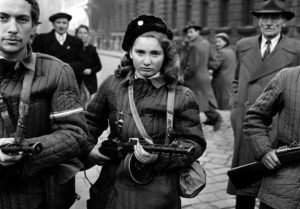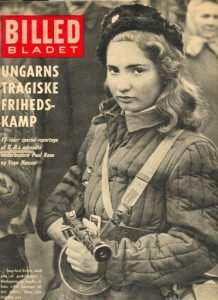The heroes of 1956: The girl, who was already dead when her photo went around the world

On the 13th of November, 1956, a red-haired, freckled, quilted coated, 15-year-old Hungarian girl looked at the readers of the Danish Billed Bladet from the cover, with proud defiance in her eyes. She held a Russian cartridge-disc rifle in her hands. The photo of Erika Szeles went around world press. According to szeretlekmagyarorszag.hu, many people looked at the photo as the symbol of the Hungarian revolution, the symbol of courage and hope. But no one knew that the girl was already dead when her photo was published on the cover of the Danish newspaper.
The revolutionary girl was shot to death on the 7th of November, when she was trying to help the injured in a Red Cross armband. The bullet came from a Soviet rifle and hit Erika on her neck. But who was this girl? A Danish man and the fact-finding Hírszerző portal, which doesn’t exist anymore, found out about her life a few years ago.
The photo that went around the world was made by Danish journalists. Paul Raae and his photographer, Vagn Hansen got to Hungary in the autumn of 1956 with a lot of luck as they didn’t have any permission to enter the country. They joined a Red Cross convoy with their small Volkswagen, so they were among the firsts to get to Budapest. The Danish were shocked by what they saw.
Paul Raae reported with aghast astonishment on how the crowd rushed at the State Defence Authority with bare fists. They saw a girl who jumped in front of a Russian tank to stop it. They also took photos of victims, revolutionaries, youngsters and the elderly. They were at the Üllői Road, near the Kilián barrack, and at the Köztársaság Square.
Meanwhile, they met Erika. The famous Danish photographer, asked by Hírszerző, remembered the moment precisely, even decades later. “I accidentally managed to take a photo, which went around the world and became the symbol of the revolution. I saw a beautiful, bloused and armed girl with a serious look on her face, and I convinced her to pose for a few photos.”

This serious looking, beautiful girl was born in the 13th district of Budapest. Erika was three years old when she lost her father due to the war. She was brought up by her mother. She studied cookery and worked in the Béke Hotel in the autumn of 1956.
She often visited her uncle’s literature club. Endre Bondi was known as a conductor, composer and writer. “The 15-year-old girl joined our word-fencing with surprising maturity. She had an opinion about the debates in the Petőfi Club, and she hoped for a democratic revival with fire in her eyes” wrote journalist Tamás Földes about the girl.
When the revolution broke out, she joined the rebels on the side of her friend, who was 3-4 years older than her. It might have helped in the making of the photo that Erika probably spoke a few words in Danish, because she spent some months in Denmark at the end of the 1940s. She got there with the help of a society called Red Barnet, which helped poor kids after the war.
Szeretlekmagyarorszag.hu writes that, a few days later, Erika changed her rifle to a white gown and a Red Cross armband, to help the injured on the streets. She was just helping the injured when a Soviet soldier attacked her. He rifled a series of shots that killed the girl immediately. According to her death certificate engrossed by the hospital of Péterfy Sándor Street, she died from a neck shot.
Henning Schultz was also 15 years old when Erika’s photo was published on the cover of Billed Bladet. He was deeply affected by it and sometimes wondered how great it would be to visit Hungary and find the girl, whose name he didn’t even know back then. People simply called Erika “the cover girl”.

50 years passed and the retired geographer started a quest after the girl. He planned to find the heroic girl and give her three copies of the Danish Billed Bladet which he set aside in 1956.
He first started looking for information on internet forums but he barely found anything. So he travelled to Hungary and looked up the Hungarian National Museum’s Historic Picture Gallery to ask for help. He talked enthusiastically about the girl who he and his friends once admired so much.
“We all came to love her and thought that she was very strong, brave and pretty” said Schultz. But his trip wasn’t successful. He contacted several Hungarian magazines to publish the photo so that someone might recognize Erika. Finally, Magyar Nemzet did so, but it didn’t bring a breakthrough.
[button link=”https://dailynewshungary.com/song-commemorating-60th-anniversary-1956-revolution-released-video/” type=”big” newwindow=”yes”] Official song commemorating the 60th anniversary of the 1956 revolution[/button]
So Schultz gifted the newspapers to the Hungarian National Museum in 2008. He also settled for the museum to receive the signed copies of photographer Vagn Hansen’s twelve ’56 photos, which were exhibited later.
However, the quest wasn’t completely unsuccessful. Schultz found a Danish article from 1981, in which a ’56 refugee, József Árki told that he went to the same cookery school the 15-year-old girl went to.
Hírszerző dealt with the story of the famous photo and eventually one of the journalists of the portal, Adél Tossenberger, found out Erika’s surname based on Henning Schultz’ and Tamás Földes’s recollection. She then found the grave of the girl, who died a hero’s death at the age of 15, in the Kerepesi cemetery.
“My dear little girl, my Erika, never to be forgotten, 1941. I. 6. – 1956. XI. 7.” as her epitaph says.
Photos: www.szeretlekmagyarorszag.hu
Copy editor: bm
Source: http://www.szeretlekmagyarorszag.hu/






I am the man bebind the fibding of your wonderful freedomfighter ERIKA. If you want the whole histiory, send your email to me.
I am : henning@£h53.dk. Best wishes Henning.
Dear readers.
My emeil was wrong.
The correct email is: henning@h53.dk